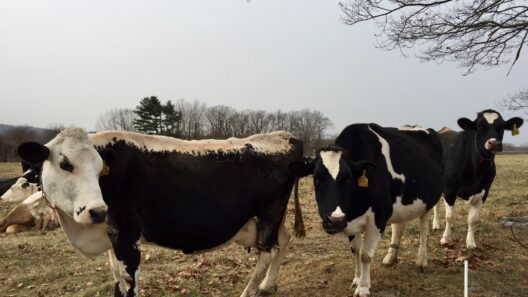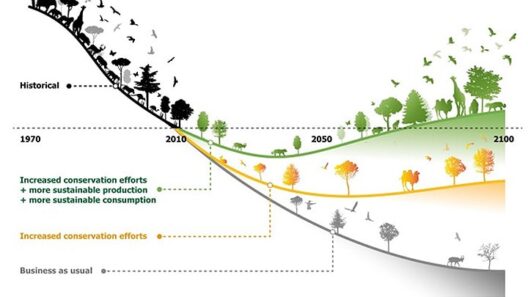Industrial agriculture has revolutionized the way food is produced, optimized for efficiency and profitability. However, this transition has not come without significant consequences. The Food Factory Effect, as it can be termed, encapsulates the myriad ways that mechanized farming and large-scale food production contribute to climate change. But what if our quest for efficiency is also unraveling the very fabric of our environment? Is it possible that the very systems designed to nourish us are simultaneously taxing our planet? Let’s delve into this complex interplay and uncover the harsh realities lurking beneath our food systems.
To understand the Food Factory Effect, we must first recognize the concept of industrial agriculture. This model is characterized by the use of advanced technology, monoculture practices, and the application of synthetic fertilizers and pesticides. The goal is to maximize output while minimizing costs. Unfortunately, this approach often leads to the overutilization of natural resources, particularly soil and water, and an alarming increase in greenhouse gas emissions.
One major consequence of industrial agriculture is the reliance on fossil fuels. The machinery used in planting, cultivating, and harvesting crops requires substantial amounts of fuel. Tractors, combines, and transportation vehicles all contribute to the carbon footprint of food production. This dependency is further compounded by the energy-intensive processes involved in manufacturing fertilizers and pesticides. In fact, fertilizers alone are responsible for approximately 20% of global greenhouse gas emissions. The question arises: can we sustain our current food production system without exacerbating climate change?
Additionally, the practice of monoculture—growing a single crop over vast areas—poses severe risks to biodiversity. These expansive fields of genetically similar plants decrease ecological resilience, making crops more susceptible to pests and disease. This, in turn, leads to increased pesticide application, which can create a vicious cycle of chemical reliance. As we strip away the complexity of nature, are we not jeopardizing our future food security?
Soil degradation is another pressing concern. Conventional farming techniques often lead to the depletion of vital nutrients within the soil, eroding its structure and severely limiting its ability to sequester carbon. Healthy soil is paramount for capturing carbon dioxide from the atmosphere, serving as a natural buffer against climate change. However, when policies favor industrial farming, the soil’s capability to perform this critical function is compromised. The degradation of soil health thus contributes to an increase in atmospheric carbon levels. Is it too late to change our practices before we face the perilous consequences of our soil loss?
The implications of industrial agriculture extend to water resources as well. The overuse of water for irrigation and livestock production is staggering. Regions that rely heavily on agriculture often experience significant water stress, leading to conflicts over this precious resource. Moreover, runoff from fertilizers and animal waste contaminates water bodies, resulting in harmful algal blooms and the death of aquatic ecosystems. As our demand for cheap, mass-produced food grows, are we setting the stage for severe water shortages and ecological calamity?
A significant issue that accompanies industrial agriculture is animal agriculture. The livestock sector alone contributes nearly 15% of global greenhouse gas emissions. Cattle, for instance, produce methane—a potent greenhouse gas that is more effective than carbon dioxide at trapping heat in the atmosphere. The exponential growth of factory farms, combined with the increasing demand for meat and dairy products, is creating a perfect storm of emissions. Can we transition toward more sustainable diets that promote plant-based alternatives and reduce our reliance on fossil-fuel-intensive animal farming?
Another critical factor contributing to climate change is food waste. In the United States, nearly 40% of food is discarded, from farm to plate. The resources expended on producing this wasted food—water, energy, labor—are significant. When food is thrown away, all the associated greenhouse gas emissions derived from its production go to waste as well. If we could eliminate food waste, we could drastically reduce emissions and conserve precious resources. The challenge lies in rethinking our food consumption patterns. What innovative strategies could we implement to reduce waste and conserve energy?
Moreover, the global market influences industrial agriculture dramatically. Large agribusiness corporations often exert significant control over what is produced and how it is grown. This control perpetuates monoculture practices and the dependence on chemical inputs. When profit-driven motives supersede ecological considerations, sustainability takes a backseat. The challenge here is to cultivate an economic system that rewards environmentally conscious choices. Can innovative policies and consumer advocacy nudge us toward a more sustainable agricultural future?
The urgent need for reform in industrial agriculture cannot be overstated. Transitioning to regenerative agricultural practices that prioritize soil health, biodiversity, and sustainable land use is paramount. By implementing mixed cropping systems, cover cropping, and reduced tillage, we can enhance soil carbon sequestration and improve ecological resilience. Furthermore, embracing agroecology can help offset emissions from industrial practices, contributing to sustainable food systems that harmonize production with environmental stewardship.
As consumers, we hold significant power to influence the food industry through our purchasing choices. Supporting local farmers, prioritizing organic practices, and reducing consumption of heavily processed foods can help reduce the harmful effects of the Food Factory Effect. Additionally, fostering community initiatives focused on sustainable practices can amplify our efforts toward climate mitigation.
In conclusion, the Food Factory Effect starkly illustrates the complex relationship between industrial agriculture and climate change. The challenges are multifaceted, but they are not insurmountable. By prioritizing sustainable practices, advocating for environmental policies, and rethinking our consumption habits, we can work collectively to mitigate the impact of agriculture on our planet. As we face escalating climate challenges, the question remains: are we ready to rethink our food systems and embark on a path toward sustainability, or will we remain entrenched in a cycle of environmental degradation?






